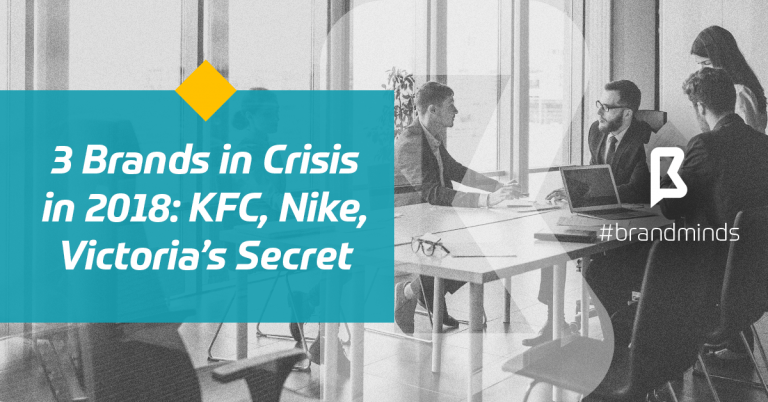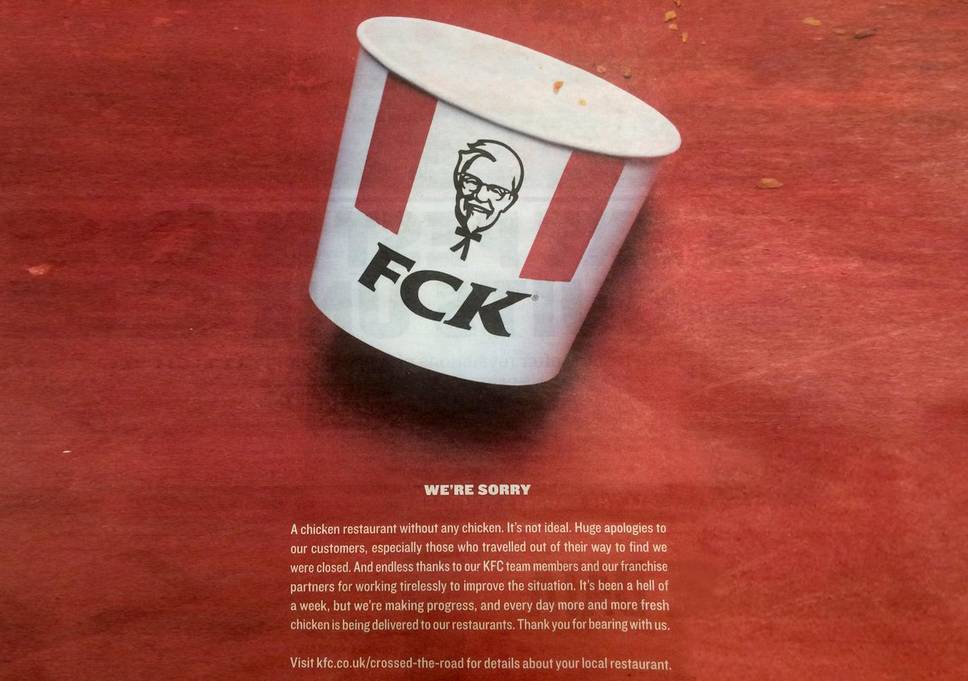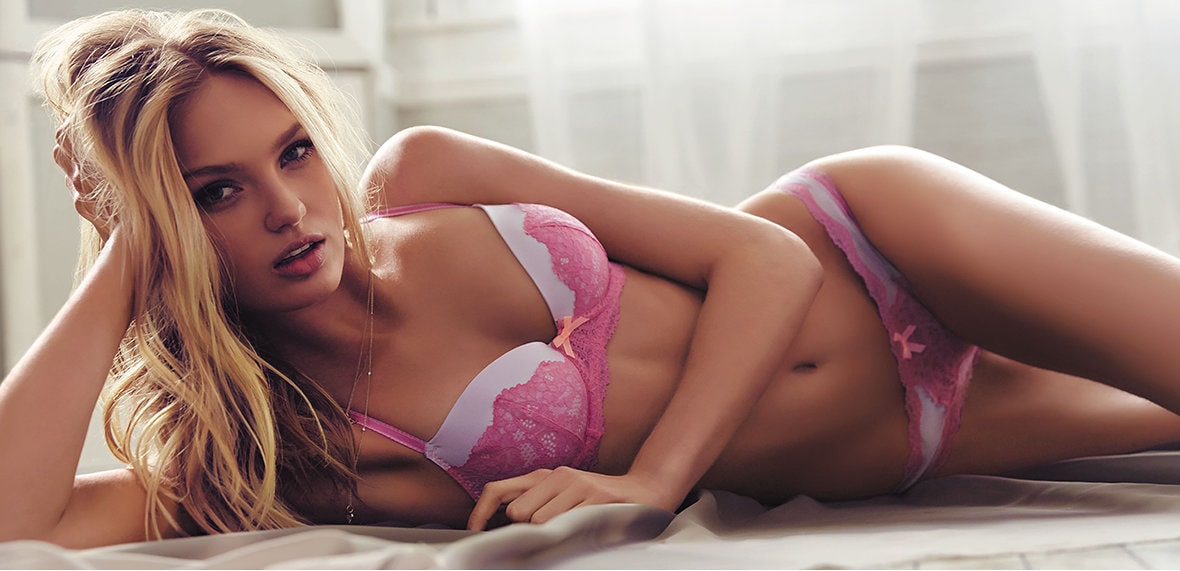
Crisis. A word feared by all brands. No brand wishes to experience crisis and yet unexpected events, reactions or consequences do happen. What sets great brands apart from the rest is the way they manage crisis.
Let’s see how KFC, Nike and Victoria’s Secret managed crisis in 2018!
KFC
In February 2018, KFC runs out of chicken which leads to 900 restaurants across UK and Ireland closing their doors for a few days. The reason? DHL, KFC’s current shipping agent failed to deliver fresh chicken to the said restaurants.
Reactions
Finding their favourite fast-food restaurants unable to sell their delicious chicken menus, people didn’t hold back on expressing their disappointment. They turned to social media to cry out their frustration under #KFCcrisis.
Others contacted police in large numbers.
Please do not contact us about the #KFCCrisis – it is not a police matter if your favourite eatery is not serving the menu that you desire.
— Tower Hamlets Police (@MPSTowerHam) 20 februarie 2018
How did KFC deal with the crisis?
- The company set up an online service where those who couldn’t wait for fried chicken could find the nearest branch that remained open.
- The company published an apology ad as a full-page advertisement in UK newspapers.
FCK
WE’RE SORRY
A chicken restaurant without any chicken. It’s not ideal. Huge apologies to our customers, especially those who travelled out of their way to find we were closed. And endless thanks to our KFC team members and our franchise partners for working tirelessly to improve the situation. It’s been a hell of a week, but we’re making progress and every day more and more fresh is being delivered to our restaurants. Thank you for bearing with us.
Visit kfc.co.uk/crossed-the-road for details about your local restaurant.

Conclusion
KFC crafted an apology ad using humour and honesty in an authentic way which attracted a lot of media coverage and brand love from its customers.
NIKE
Nike published its Dream Crazy ad on September 5, 2018 with Colin Kaepernick as the narrator. In just three months, the video gained over 27 Million views making it the brand’s most viewed ad on YouTube.
Colin is a former NFL player who attracted outrage from the public when he protested against police brutality by kneeling during the American anthem. Because of his controversial profile, Nike’s ad received a lot of media coverage, mixed reviews and strong emotional feedback from the public.
Reactions
Here are some of the reactions Nike received in the days after the ad was launched:
- Some people set their Nike sneakers on fire;
- #boycottnike became a trending hashtag on Twitter;
- Others cut the Nike logo off their socks;
- Nike’s share price dropped by 3.2% to finally go up to an all-time high, earning the company $6 billion.
Nike is on the right side of history with this ad.
Spike Lee, Film Director
Realeyes, the emotional intelligence platform analysed the overall sentiment towards Nike by looking at the ad’s viewers’ comments.
What did the consumers really think of Dream Crazy?
Here it is according to Realeyes:
- 50% of negative verbatims are about Kaepernick, not the ad itself;
- Negative emotions are due to narrative, not Kaepernick;
- Men garnered more negative emotions;
- Women instinctively more positive towards the ad;
- Middle-aged demographic the least positive.
Some analysts were asking this rhetoric question:
What was Nike thinking about?
The answer is: although Dream Crazy divided the public into supporters and detractors, Nike knew exactly what it was doing.
Actually, the brand has a 30-year experience with controversial, out of the mainstream ads. Dream Crazy is the epitome of a series of risky ads which began with the first JustDoIt ad published back in 1988. Over the next years, the brand’s ads supported various social subjects such as gender equality, woman empowerment, sexual minorities, ageism, disability etc. With each controversial ad, Nike revenues have grown exponentially.
How did Nike deal with the crisis?
Faced with the outrage of some of his customers, Nike has taken no steps to address this crisis.
Nike doesn’t shy away from risk and controversy because starting the conversation on important social subjects stands at the core of its brand values.
It’s safe to say the company has run the numbers before publishing the ad and was ready for any backlash it might have had. According to an ESPN Twitter poll which asked their followers how the ad affected their decision to buy Nike products: 29% said they are more likely to buy Nike products, 21% say they’re less likely and 50% said their decision has not been affected.
Conclusion
Dream Crazy was aimed at the younger generations with the purpose of increasing their fan base. Millennials are known to love and support brands which are committed to their core values and are not shy to stand by them.
According to Edison Trends, Nike’s online sales jumped 25%.
It looks like Nike have taken a controlled risk and came out on top.
VICTORIA’S SECRET
Victoria’s Secret has been experiencing brand crisis for the past few years and its management is slow to even recognize it let alone address it effectively.
Management myopia
The company is currently facing decreased sales and shrunken profit due to management myopia. Here on the BRAND MINDS blog, I have written about myopia as an early symptom of brand failure in our Failure Series articles: Nokia and Kodak.
Far from me to assume the role of Pithya, but as history has shown, if the company loses its grip on reality and doesn’t embrace change, the chances of survival are getting smaller every year that goes by.
Victoria’s Secret has never changed, but the world around them has. I was walking through the subway station the other day in Manhattan and I looked at the ad for the Angels’ ‘fantasy’ runway show and I said to myself: ‘That could be today, or 30 years ago.’
Michelle Cordeiro Grant, former senior merchant director at Victoria’s Secret via theguardian.com

image source: victoriassecret.com
Over the past few years, the company was faced with backlash from the public regarding various subjects such as competitive anorexia that Victoria’s Secret models are suffering from, Photoshopped ad campaigns and the Victoria’s Secret show which the US’s National Organization of Women (NOW) dubbed as “softcore porn infomercial” in 2002.
Mr. Razek’s Vogue Interview
The latest scandal which brought Victoria’s Secret into the spotlight is the interview of Ed Razek, CTO published by Vogue Magazine in July 2018. In this interview, the brand’s problems became clear to everyone: lack of inclusiveness, lack of sexual diversity, disengagement with its customers’ needs and expectations, outdated marketing.
Mr Razek’s words attracted the outrage of female public. Essentially, Mr. Razek said that Victoria’s Secret supports the woman as long as she portrays herself as the object of the heterosexual white male’s fantasies.
Victoria’s Secret is losing share to other brands because it’s out of touch. The way it’s marketing is out of touch. Women don’t want to be viewed as stereotypical sexy supermodels buying lingerie just to impress men.”
Paul Lejuez, retail analyst focused on L Brands via nytimes.com
Victoria’s Secret, founded by Roy Raymond in 1977 is seeing increased competition from other lingerie brands such as ThirdLove, Aerie and Savage x Feinty by Rihanna, startup companies founded by women.
These companies feature real women in their advertisements, of all sizes, shapes and colours. While Victoria’s Secret designs its products with the white male in mind, their products are designed to meet women’s needs of comfort, beauty and sexiness.
Following the Vogue interview, ThirdLove published an open letter and launched a petition to boycott the Victoria’s Secret fashion show this year in an attempt to force the brand to “be more diverse and inclusive of body shapes and sizes on their runways.”
Women are tired of trying to comply to Victoria’s Secret’s narrow standards of sexiness and are looking for brands which support a healthy body image.
How did Victoria’s Secret deal with the crisis?
The first step following Mr. Razek’s interview was Jan Singer stepping down as the company’s CEO. No other measures have been announced so far.
Conclusion
The company is in dire need of re-branding and re-evaluation.
Women have changed since the 1980s and if the brand doesn’t keep up with its clients, it will get out-marketed and out-competed by other lingerie brands.
Although a lot smaller than Victoria’s Secret, these brands are more in tune with their customers. And this is the winning recipe.
sources:
https://www.forbes.com/sites/andriacheng/2018/07/12/heres-the-real-problem-behind-victorias-secrets-dramatic-fall/#7ecb280a1054
https://www.forbes.com/sites/andriacheng/2018/11/19/victorias-secret-facing-a-slide-in-sales-and-profit-is-in-need-of-a-new-brand-pitch-fast/#15e79acf4d70
https://www.vogue.com/article/victorias-secret-ed-razek-monica-mitro-interview
https://www.teenvogue.com/story/thirdlove-response-victorias-secret-ed-razek-interview
https://www.forbes.com/sites/yolarobert1/2018/11/26/victoriassecretreplacesceo/#21bbeb246194
https://www.vox.com/the-goods/2018/11/8/18068148/victorias-secret-fashion-show-2018-history-controversy
https://www.theguardian.com/lifeandstyle/2018/nov/22/victorias-secret-show-angels-lingerie
https://www.telegraph.co.uk/news/2018/02/20/kfc-chicken-shortage-causes-chaos-police-tell-customers-stop/





















